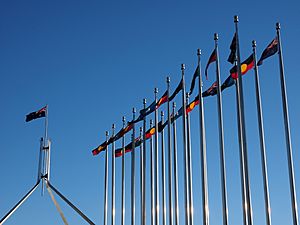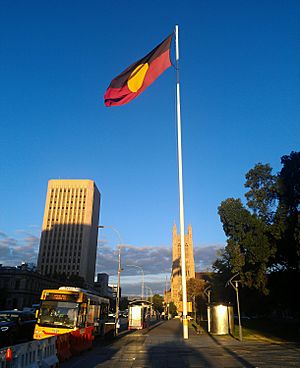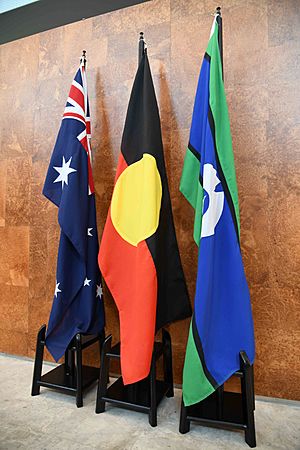Australian Aboriginal Flag facts for kids
 |
|
| Proportion | 2:3 (as depicted above) or 1:2 |
|---|---|
| Adopted | 14 July 1995 |
| Design | A horizontal bi-colour of black and red with a yellow disc in the centre. |
| Designed by | Harold Thomas |

The Australian Aboriginal Flag is a very important symbol for Aboriginal Australians. It is one of Australia's official flags. This means it has a special legal and political status. It is often flown alongside the national flag and the Torres Strait Islander Flag.
The flag was created in 1971 by Harold Thomas. He is an Aboriginal artist from the Luritja people of Central Australia. Mr. Thomas designed the flag for the land rights movement. It quickly became a powerful symbol for Aboriginal people across Australia.
The flag has two equal horizontal halves. The top half is black, and the bottom half is red. A bright yellow circle sits right in the middle. The flag is usually made with a 2:3 proportion. However, you might also see it in a 1:2 proportion, like the Australian National Flag.
Contents
What Does the Aboriginal Flag Mean?
The Colours and Their Symbolism
Harold Thomas, the flag's designer, explained what each part of the flag means:
- Black – This colour stands for the Aboriginal people of Australia.
- Yellow circle – This bright circle represents the Sun. The Sun gives life and protects everyone.
- Red – The red colour has two important meanings. It can represent the red earth, which is very important in Aboriginal ceremonies. It also shows Aboriginal peoples’ deep spiritual connection to the land. The red can also represent the blood of the Aboriginal people.
How the Flag Became Official
The Government of Australia made the Aboriginal Flag an official "Flag of Australia." This happened on 14 July 1995, under a law called the Flags Act 1953. This decision gave the flag special recognition.
In 2008, the government confirmed its status again. The flag was recognised as the flag of the Aboriginal peoples of Australia. It was also seen as a flag important to the whole Australian nation.
History of the Flag
The Aboriginal Flag was first flown on 9 July 1971. This was during National Aborigines Day in Victoria Square in Adelaide. It was also used in Canberra at the Aboriginal Tent Embassy starting in late 1972. The Tent Embassy is a protest site for Aboriginal land rights.

In 1994, athlete Cathy Freeman caused a stir at the 1994 Commonwealth Games. She carried both the Aboriginal flag and the Australian national flag after winning her races. Usually, only the national flag is displayed. Despite some criticism, she carried both flags again.
In 1995, Prime Minister Paul Keating decided to give the Aboriginal and Torres Strait Islander flags official status. Some politicians disagreed at the time. However, these flags have remained national flags ever since.
The Aboriginal flag has been flown over the Sydney Harbour Bridge during important events. This includes marches for reconciliation and Australia Day celebrations. In February 2022, the New South Wales government announced the flag would fly permanently on the Harbour Bridge.
In 2001, for the flag's 30th anniversary, thousands of people took part in a special ceremony. They carried the flag from the Parliament of South Australia to Victoria Square.
Where the Flag is Used
Public Buildings and Locations
The first city council to fly the Aboriginal flag was Newcastle City Council in 1977. Many other city councils across Australia now fly the flag. For example, the Adelaide City Council decided in 2002 to fly the flag permanently in Victoria Square. It also flies in front of the Adelaide Town Hall.
The flag is also flown at many state Parliament Houses, including in Victoria. Police stations in New South Wales are also starting to fly the flag. Since March 2021, the Australian Embassy in Dublin, Ireland, has permanently flown the Aboriginal flag.
After the 2022 Australian federal election, the new government started displaying the Aboriginal and Torres Strait Islander flags. They are now shown alongside the national flag at ministerial press conferences. Both flags are also displayed in the House of Representatives and Senate chambers.
From May 2022, both flags were hoisted at Government House, Adelaide. They now fly permanently alongside the national flag and the South Australian flag.
Other Uses
Aboriginal-designed emojis, called Indigemojis, were released in 2019. They include the flag on some designs.
Copyright of the Flag
Harold Thomas, the flag's designer, owned the copyright to the flag. This meant he had the legal right to control how the flag was used and reproduced. In 1997, the Federal Court of Australia confirmed his ownership of the copyright.
For many years, only certain companies had permission to make and sell the flag. This led to some disagreements, as many Aboriginal people felt the flag should be freely used by everyone. A "free the flag" campaign started to allow wider use.
Copyright Transfer to the Government
On 24 January 2022, a big announcement was made. Harold Thomas transferred the copyright of the flag to the Commonwealth government. This means the flag can now be used freely by all Australians. People no longer need to ask for permission or pay a fee to use it.
The government stated that the Aboriginal Flag will now be managed like the Australian National Flag. This means its use is free, but it must always be shown in a respectful way. Australians can now put the Aboriginal Flag on clothing, paint it on sports grounds, use it on websites, and in artworks without any restrictions.
Harold Thomas still has "moral rights" over the flag. This means he will always be recognised as its creator. Royalties from the flag's use will go to the National Aborigines and Islanders Day Observance Committee. This money will support activities related to the flag.
Many Aboriginal people celebrated this decision. However, some felt that the flag should be controlled by an Indigenous organisation, not the government.
See Also
 In Spanish: Bandera de los aborígenes de Australia para niños
In Spanish: Bandera de los aborígenes de Australia para niños
- Flags of Australia
- Torres Strait Islander Flag
- Ethnic flag






